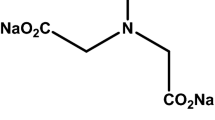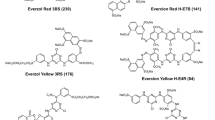Abstract
Cotton fabric is usually dyed with reactive dyes. During the dyeing process, a large amount of salt is required to achieve higher exhaustion of the dye from the dyebath onto the fiber. Dyeing of cotton with reactive dyes has a substantial environmental impact due to the discharge of a large volume of highly colored and saline effluents. Chemical cationization allows cotton fibers to be dyed without salt by chemically modifying cellulosic macromolecules to introduce positively charged sites. In this study, cotton fabric was cationized using (3-chloro-2-hydroxylpropyl) trimethyl-ammonium chloride (CHPTAC). Dye uptake was assessed using two reactive dyes, CI Reactive Blue 235 and CI Reactive Blue 19. Dye exhaustion kinetics were determined using a Datacolor-HueMetrix Monitor system. Analysis of variance demonstrated significant effects of CHPTAC concentration and exhaustion time on the percent exhaustion. Color strength at the end of the dyeing cycle was significantly higher for cationized fabrics compared to the control fabric. This work shows that treatment of cotton with CHPTAC enhanced dye uptake properties due to the introduction of cationic sites and resulted in superior dyeing without the addition of salt.














Similar content being viewed by others
References
Acuner E, Dilek FB (2004) Treatment of tectilon yellow 2G Chlorella vulgaris. Process Biochem 39:623–631
Aksu Z, Kılıç NK, Ertuğrul S, Dönmez G (2007) Inhibitory effects of chromium (VI) and Remazol Black B on chromium (VI) and dyestuff removals by Trametes versicolor. Enzyme Microb Technol 40:1167–1174
Asgher M, Bhatti HN (2012) Removal of reactive blue 19 and reactive blue 49 textile dyes by citrus waste biomass from aqueous solution: equilibrium and kinetic study. Can J Chem Eng 90:412–419
Blackburn RS, Burkinshaw SM (2002) A greener approach to cotton dyeings with excellent wash fastness. Green Chem 4:47–52. doi:10.1039/b111026h
Blackburn RS, Burkinshaw SM (2003) Treatment of cellulose with cationic, nucleophilic polymers to enable reactive dyeing at neutral pH without electrolyte addition. J Appl Polym Sci 89:1026–1031
Chattopadhyay DP, Chavan RB, Sharma JK (2007) Salt-free reactive dyeing of cotton. Int J Cloth Sci Technol 19:99–108. doi:10.1108/09556220710725702
Ferrero F, Periolatto M (2011) Dyes adsorption on functionalized fibrous materials. Chem Eng Trans 25:1037–1042
Frazer L (2002) A cleaner way to color cotton. Environ Health Perspect 110:A252–A254
Hashem M, Hauser PJ, Smith B (2003) Reaction efficiency for cellulose cationization using 3-chloro-2-hydroxypropyl trimethyl ammonium chloride. Text Res J 73:1017–1023. doi:10.1177/004051750307301113
Hauser PJ (2000) Reducing pollution and energy requirements in cotton dyeing. Text Chem Color Am Dyest Rep 32:44–48
Hauser PJ, Tabba AH (2001) Improving the environmental and economic aspects of cotton dyeing using a cationised cotton. Color Technol 117:282–288
Kanik M, Hauser PJ (2004) Printing cationized cotton with direct dyes. Text Res J 74:43–50. doi:10.1177/004051750407400108
Kannan MSS, Gobalakrishnan M, Kumaravel S, Nithyanadan R, Rajashankar KJ, Vadicherala T (2006) Influence of cationization of cotton on reactive dyeing. J Text Appar Technol Manag 5:1–16
Karahan HA, Özdoğan E, Demir A, Ayhan H, Seventekin N (2008) Effects of atmospheric plasma treatment on the dyeability of cotton fabrics by acid dyes. Color Technol 124:106–110. doi:10.1111/j.1478-4408.2008.00129.x
Khalil-Abad MS, Yazdanshenas ME, Nateghi MR (2009) Effect of cationization on adsoprtion of silver nanoparticles on cotton surfaces and its antibacterial activity. Cellulose 16:1147–1157
Khatri A (2011) Use of biodegradable organic salts for pad-steam dyeing of cotton textiles with reactive dyes to improve process sustainability. In: International conference on education research and innovation IPEDR. IACSIT Press, Singapore, pp 84–89
Klemm D, Heublein B, Fink HP, Bohn A (2005) Cellulose: fascinating biopolymer and sustainable raw material. Angew Chemie Int Ed 44:3358–3393
Lewis DM, Vo LTT (2007) Dyeing cotton with reactive dyes under neutral conditions. Color Technol 123:306–311
Liu Z-T, Yang Y, Zhang L, Liu Z-W, Xiong H (2007) Study on the cationic modification and dyeing of ramie fiber. Cellulose 14:337–345
Montazer M, Malek RMA, Rahimi A (2007) Salt free reactive dyeing of cationized cotton. Fibers Polym 8:608–612
Park S, Baker JO, Himmel ME, Parilla PA, Johnson DK (2010) Cellulose crystallinity index: measurement techniques and their impact on interpreting cellulase performance. Biotechnol Biofuels 3:1–10. doi:10.1186/1754-6834-3-10
Patiño A, Canal C, Rodríguez C, Caballero G, Navarro A, Canal JM (2011) Surface and bulk cotton fibre modifications: plasma and cationization. Influence on dyeing with reactive dye. Cellulose 18:1073–1083. doi:10.1007/s10570-011-9554-7
Plastina A (2009) Cotton’s share of world textile fiber use continues to decline. http://www.icac.org/meetings/plenary/68_cape_town/documents/bo3/bo3_e_icac.pdf. Accessed 27 Apr 2012
Rong L, Feng G (2006) Dyeing properties of PECH-amine cationized cotton with acid dyes. J Appl Polym Sci 100:3302–3306. doi:10.1002/app.23155
Shore J (1995) Cellulosics dyeing. The Society of Dyers and Colourists, West Yorkshire
Siddique M, Farooq R, Shaeen A (2011) Removal of Reactive Blue 19 from wastewaters by physicochemical and biological processes-A Review. J Chem Soc Pak 33:284–293
Tarburk A, Grancaric AM, Leskovac M (2014) Novel cotton cellulose by cationisation during the mercerization process-part I: chemical and morphological changes. Cellulose 21:2167–2179
Teng X, Ma W, Zhang S (2010) Application of tertiary amine cationic polyacrylamide with high cationic degree in salt-free dyeing of reactive dyes. Chin J Chem Eng 18:1023–1028. doi:10.1016/S1004-9541(09)60163-4
Tutak M (2011) Reactive dyeing of cationized cotton: effects on the dyeing yield and the fastness properties. J Appl Polym Sci 119:500–504. doi:10.1002/app
Wang H, Zheng XW, Su JQ, Tian Y, Xiong XJ, Zheng TL (2009a) Biological decolorization of the reactive dyes Reactive Black 5 by a novel isolated bacterial strain Enterobacter sp. EC3. J Hazard Mater 171:654–659
Wang L, Ma W, Zhang S, Teng X, Yang J (2009b) Preparation of cationic cotton with two-bath pad-bake process and its application in salt-free dyeing. Carbohydr Polym 78:602–608. doi:10.1016/j.carbpol.2009.05.022
Acknowledgments
The authors would like to thank Bayer CropScience for financial support. Texas Tech University manuscript number T-4-659.
Author information
Authors and Affiliations
Corresponding author
Rights and permissions
About this article
Cite this article
Acharya, S., Abidi, N., Rajbhandari, R. et al. Chemical cationization of cotton fabric for improved dye uptake. Cellulose 21, 4693–4706 (2014). https://doi.org/10.1007/s10570-014-0457-2
Received:
Accepted:
Published:
Issue Date:
DOI: https://doi.org/10.1007/s10570-014-0457-2




